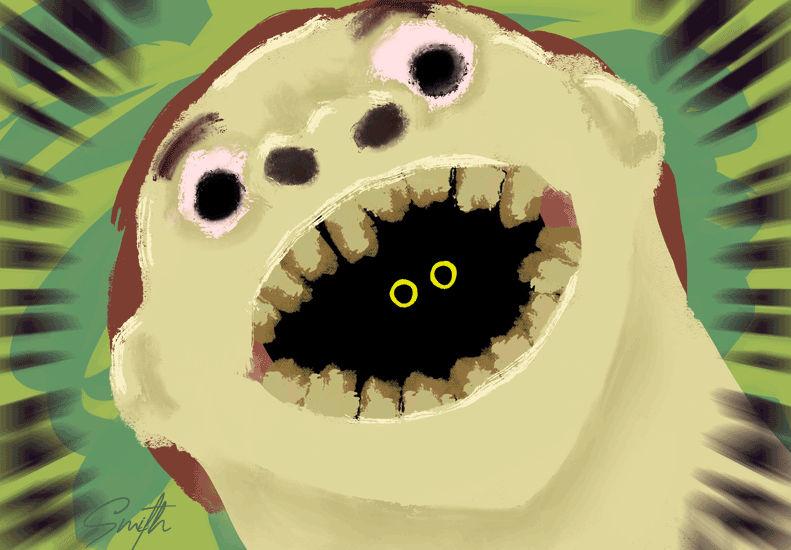Sometimes a crime is so horrible, it lives on forever as a legend. Such is the case with the legend of the ratcheting monk from Görlitz, Germany, a legend known in german as the “Klötzenmönch”. A legend in which a monk broke his vows and committed a murder, and a young girl paid the price.
But was it real? Can names be placed to the murderer and his victim?
What is the story of the “Klötzelmönch”?
The tale goes like this: A young handworker was traveling through the town of Görlitz while looking for work. He heard the bell in the monastery calling people to prayer and, being devout, went inside for the service. He was so tired from traveling that he promptly fell asleep. When he finally awoke, he was horrified to discover that everyone had gone, the service had long since been over, and he was locked inside. But even more terrifying was the strange clomp-stomp sound of limping footsteps as someone approached. The boy hid in the pews and watched as the heavy iron cloister door opened and an ugly monk appeared, dragging a lifeless body behind him. Unable to move or speak, the boy shook helplessly as the monk lifted a heavy stone plate from the floor and dropped the body of a slight, blonde girl into it. Finished, the monk left the way he came, and the boy remained trapped until morning.
When daylight came and the church was reopened, the boy sneaked out and made his way to a hostel. There he heard news of the girl’s disappearance, as her widowed mother had been looking for her all night. The girl went to mass and had never come home.
The boy ended up telling the authorities all he knew, and when they looked under the loose stone slab beneath the altar, they found the body of the girl just as he had witnessed. The ugly monk was easily found, and he ended up confessing to his crime. Through tears he explained that he had lured the girl to his room, used her and murdered her to keep her silent. His punishment was death by entombment in a wall in the cloister.
It was said that he haunted the monastery, and his ghost was called the Klötzelmönch or ratcheting monk because of the wooden slippers he wore and the harsh, foreboding sound they made as he dragged his feet across the stone floor.
When could the events have taken place?
If the story really did happen, when could it have taken place? In order to determine this, let’s look at when the Franciscan monks were active in the town of Görlitz. In the years between 1234 and 1245, the Holy Trinity Church was built in front of the city gates where the Obermarkt, or upper market area, still exists today. The monks of the Franciscan order initially used it as a monastery church, according to Wikipedia. Wikipedia also states in another article about Görlitz that in 1563, the last Franciscan monk handed over the monastery to the city with the condition that a grammar school be set up in its place. That means there is a 300 year period during the middle ages when such a murder could have occurred.
With the help of an article in ViaOla online magazine, we can narrow down the time frame even further. The article mentions a reform in 1462 that made the monks renew their vows of poverty. It adds that it was during this time that the legend of the Klötzelmönch began to spread.
Why would townsfolk spread a rumor?
The Franciscan monks seemed to get along well with the townsfolk and, in fact, the town benefited because the monks were not allowed to own property. So why would locals spread the rumor that would become the legend of the Klötzelmönch? The reform in 1462 came about because of division in the monk’s order. Some monks continued strict observance of their vows, while others did not. Some monks could share property, for instance. Perhaps the legend served as a warning not to trust monks who were not strict with their vows.
But did any real evidence survive of such a murder?
Who could the Ratcheting Monk have been?
“Only at the beginning of this century, when the building...connected with the monastery was pulled down, his walled-in bones were found and buried in consecrated earth. However, the picture of the monk and that of the mother, who was anxiously looking for her daughter, were put up by a citizen of Goerlitz on the house where the girl had lived... According to legend, an underground passage led from this...monastery to the Landskrone. Once three students entered, walked a quarter of an hour in it, but then came to an iron door which they were unable to open. Later the entrance was walled up.” - Excerpt from the book Sagenbuch des Preußischen Staats by Johann Georg Theodor Grässe
If this account of the events were true, it would mean that somewhere lies buried the remains of the monk. It would also mean that there was agreement among the townspeople as to where the victim had lived. Most legends are not so precise. And yet, there are no names attached to this tale. No gravestone of the murderer to show to tourists, and no grave of the victim. It would seem that if these things were known, they would be used to attract more visitors to the area.
It is worth noting that, during this period in history, criminal records typically were not kept. There existed no criminal registry in Germany until 1882, according to an article in Oxford Academic. Civil cases about land disputes and the like do exist from this time period, however, they would not have provided any information regarding a murder. As a result, whoever the ratcheting monk might have been—if any murder had really taken place at all—has been lost to time.
What things of note regarding this legend can be seen in the town today?
“The house on the corner of Fleischerstraße and Brüderstraße flaunts the head of an ugly hooded monk–just as the legend describes it. He is the Klötzelmönk and stares over at the sculpture of his victim’s mother. It was officially inaugurated with a small ceremony...” - From the article “Neues Aus Der Görlitzer Sagenwelt” via KommWohnen in Görlitz website.
According to the website KommWohnen, in September of 2020, in addition to the existing figure of the mother, a new figure was added in an exposed niche discovered during a renovation in 2007. This figure is of the Klötzelmönch, and looks across the street at the sorrowful mother, perhaps longing for a forgiveness that can never come.
Notes:
Some German text was translated via Google Translate Web: https://translate.google.com/
“Görlitz”. Wikipedia. Last updated September 12, 2021.: https://de.wikipedia.org/wiki/G%C3%B6rlitz
“Geschichte von Görlitz”. Wikipedia. Last updated September 26, 2021.: https://de.wikipedia.org/wiki/Geschichte_von_G%C3%B6rlitz
“Die Sage Vom Klötzelmönch”. The city of Görlitz website: https://www.goerlitz.de/Die_Sage_vom_Kloetzelmoench.html
“Landeskrone”. The city of Görlitz website: https://www.goerlitz.de/Landeskrone.html
Johann Georg Theodor Grässe: Sagenbuch des Preußischen Staats 1-2, Band 1,Glogau, 1868/71. Pages 379-381.:http://www.zeno.org/nid/20004948548
“Neues Aus Der Görlitzer Sagenwelt”. KommWohnen. September 16, 2020.:https://www.kommwohnen.de/de/neues-aus-der-goerlitzer-sagenwelt/
File: Klötzelmönchsage Plastik wartende Mutter.JPG: https://de.wikipedia.org/wiki/Datei:Kl%C3%B6tzelm%C3%B6nchsage_Plastik_wartende_Mutter.JPG
“Die alte Klosterkirche und das ehemalige Kloster in Görlitz”. Viaola. January 27, 2017.: https://viaola.de/die-alte-klosterkirche-und-das-ehemalige-kloster-in-goerlitz/
“The Criminal Registry in the German Empire: The ‘Cult of Previous Convictions’ and the Offender’s Right to Be Forgotten”. Oxford Academic. June 5, 2021. https://academic.oup.com/gh/advance-article/doi/10.1093/gerhis/ghab039/6293741










